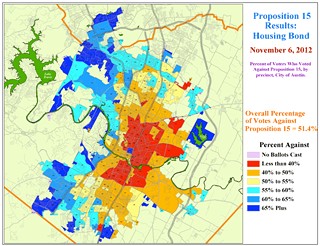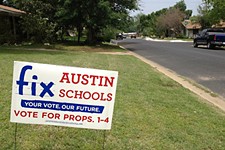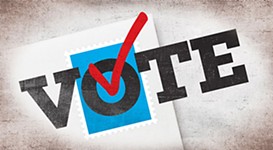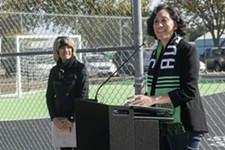Point Austin: Mapping Difference
Voting picture suggests the next Austin politics
By Michael King, Fri., Nov. 16, 2012

I was wrong last week when I speculated that the city Proposition 15 – affordable housing bonds – failed because the ballot language was so vague that voters didn't know what it was. "I'll venture a wild guess and suggest," I wrote the day after the election, that "the ballot language – '78.3 million for housing bonds' and nothing more – was simply too imprecise and inexplicable for voters considering the bottom of a lengthy November ballot." Since the vote was so close (51.4% to 48.6%, about 7,000 votes of 235,000 cast) that's probably part of the explanation – just adding the word "affordable" to the ballot could have made the difference.
But since I wrote that column, I've looked at the maps. City demographer Ryan Robinson offers his breakdowns of several of the proposition votes across the city and county. Amy Smith has more to say today about the details of the affordable housing fumble ("Then There's This"), so I won't pursue it here. But in looking at Robinson's Prop. 15 map, it struck me that he had perhaps delivered a snapshot of the city's political future. Nearly all the central city boxes – from U.S. 183 south to Ben White and beyond, and from MoPac on the west to the East and Southeast Austin boxes – voted for the housing bonds, most by above 60%. But farther west, beginning at MoPac and running northwest and southwest as well as some patches far north and far south, the percentages swung hard the other way. Most folks there voted approximately 60% against the bond.
That's not a scientific analysis – I'm looking only at percentage shadings, not numerical counts – so a better number cruncher than me would have to review those patterns to see what boxes and neighborhoods actually turned the tide against Prop. 15. But simple "ignorance" would be more random. This pattern – of voters further and further into the suburbs balking at underwriting housing bonds (while supporting roads, open space, infrastructure, public safety, libraries, even arts) while inner-city voters endorsed the bonds enthusiastically – argues for folks recognizing the choice, and breaking roughly in half.
Millions for Health, Nothing for Housing
The outcome seems also remarkable in light of the easy victory of the Central Health Prop. 1, which took in the whole county, some 340,000 voters, and won easily with nearly 55% of the vote. One would think a countywide ballot would trend more anti-tax, especially when the opposition kept citing a "huge 63% tax increase" (because the current rate is so low); and persuading 100,000 additional voters should be, in theory at least, more difficult.
The basic map pattern for Prop. 1 is roughly the same as Prop. 15: The inner-city boxes voted strongly in support, but the farther one gets from the central city, support drops first below 50% and then into 30-45% nether regions – although many of those are sparsely populated precincts.
Prop. 1 had much better PR and certainly way more money to work with than Prop. 15 (indeed, than all of the city bond propositions put together), so people understood what they were voting on and could see countywide and regional benefits. The folks promoting Prop. 15 did too little too late in getting out that kind of message, and narrowly missed their target. So, despite all the persistent talk of "loss of affordability" in lamentations about the new Austin, we couldn't see our way this time to help those most in need of that help.
It was many of the folks in the wealthiest western suburbs who pointed thumbs down.
Brave New World
So we enter the new dispensation of all-geographic districts, the sainted "10-1." That's what struck me most forcibly about the maps – there are fairly clear lines around our neighborhood political opinions, and the new political map may well upend many expectations about who votes how and where. A few days before the election, Steve Beers posted a thoughtful piece in Burnt Orange Report about city voting patterns, and he came out strongly in support of Prop. 4 (the "hybrid" system) because he believed it represented a much better chance of sustaining progressive politics – especially on environmental matters.
To put it another way, those far west districts are more likely to look like the Travis County Precinct 3 vote – where Gerald "Road Warrior" Daugherty defeated incumbent and environmental advocate Karen Huber in a campaign that consisted almost exclusively of roads, roads, and more roads. If Daugherty-like politicians begin accumulating on one side of the City Council dais, opposite, say, Eastside neighborhood advocates whose priorities might be affordability and social services, it may well be that the entertainment value of most Council meetings will extend beyond Citizens Communications.
It's something to contemplate. Austin has finally and simply grown too large for an all at-large government, in which seven people were expected to represent all of the people, all of the time. I confess I'm puzzled that folks suddenly willing to pay for three more council members, and a spanking new medical program, were not willing to pay for programs to repair decrepit housing for elderly neighbors, or to provide partly subsidized apartments for working families earning minimum wages.
Maybe next time we'll get that ballot language right. And we'll explore a Brave New City, that has such a motley crew of council members henceforth calling the shots.
Follow @PointAustin on Twitter.
Got something to say on the subject? Send a letter to the editor.












